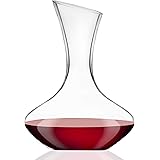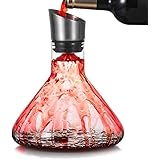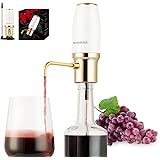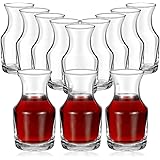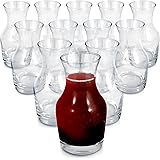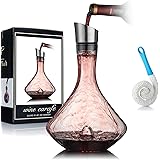Uncorking Wine Knowledge: Essential Sommelier Insights Beyond the Glass
As sommelier André Mack brilliantly highlights in the accompanying video, the world of wine is rich with tradition, science, and sometimes, a little bit of pretension. Understanding the nuances of wine, from its creation to its consumption, transforms a simple drink into a complex experience. We’re diving deeper into some of the most common and fascinating wine questions, offering expert insights to enhance your appreciation and understanding.
The Art of Aeration: Why We Swirl Wine
You’ve seen it—the graceful (or sometimes clumsy) swirl of a wine glass. This isn’t just for show; it’s a critical step in preparing wine for tasting. When wine is swirled, it increases the surface area exposed to oxygen, a process known as aeration.
Imagine if you kept a beautiful piece of art hidden away for years. You’d want to unveil it carefully, allowing its true colors and details to emerge. Similarly, wine, especially aged varieties, has been “bottled up,” and aeration helps it “breathe.” This exposure to oxygen softens harsh tannins, making the wine more approachable and allowing its aromatic compounds to volatilize and express themselves fully.
Tannins are phenolic compounds found in grape skins, seeds, and stems, as well as oak barrels. They contribute to the wine’s structure and can create a drying sensation in the mouth. Controlled aeration helps to polymerize these tannins, making them feel smoother and less astringent, revealing the wine’s hidden layers of fruit, earth, and spice.
Sparkling Wine vs. Champagne: A Matter of Place and Process
While all Champagne is sparkling wine, not all sparkling wine is Champagne. This distinction is paramount in the wine world. Champagne specifically refers to sparkling wine produced in the Champagne region of France, adhering to strict traditional methods and using particular grape varietals like Chardonnay, Pinot Noir, and Pinot Meunier.
The hallmark of true Champagne is its production via the *Méthode Champenoise*, or Traditional Method. This involves a crucial secondary fermentation occurring directly inside the individual bottle. A mixture of yeast and sugar, known as *liqueur de tirage*, is added to a still base wine, initiating this second fermentation. This process naturally produces carbon dioxide, which dissolves into the wine, creating the fine, persistent bubbles and complex, brioche-like aromas that define Champagne.
Conversely, many other sparkling wines, such as Italy’s Prosecco, often use the Charmat method. Here, the secondary fermentation takes place in large, pressurized tanks before bottling. This method is more efficient and typically yields lighter, fruitier wines with less autolytic (yeast-derived) character. Other notable sparkling wines include Spain’s Cava and various Crémants from different French regions, which also utilize the Traditional Method but originate outside Champagne.
The Grape Varietals: Beyond the Table Grapes
The vast majority of wine is made from grapes belonging to the species *Vitis vinifera*. While there are thousands of grape varietals, about 11 are most commonly used for commercial wine production. These are distinct from the larger, juicier table grapes we typically consume fresh.
Wine grapes are characterized by smaller clusters and thicker skins, which contribute significantly to the wine’s color, tannins, and complex flavors. The higher skin-to-pulp ratio in *Vitis vinifera* grapes is crucial. For red wines, the skins are a primary source of anthocyanins (color pigments) and polyphenols (including tannins), which provide structure and aging potential. Imagine trying to make a rich, deeply colored wine from a thin-skinned, watery grape—it simply wouldn’t have the same intensity or character.
Key white varietals include Chardonnay, Riesling, Sauvignon Blanc, and Pinot Grigio. Red varietals feature Cabernet Sauvignon, Pinot Noir, Merlot, Syrah/Shiraz, and Zinfandel. Each varietal brings its unique aromatic and textural profile, influenced by the *terroir* where it’s grown.
Deciphering Wine Terminology: Dry, Tannins, Body, and More
Wine language can feel opaque, but key terms help us understand what we’re drinking. “Dry” wine simply means the wine is not sweet, indicating that most or all of the grape sugars have been fermented into alcohol.
Tannins are perhaps one of the most misunderstood terms. They create a sensation of dryness or astringency in your mouth, akin to strong black tea or biting into an unripe persimmon. These polyphenols come from grape skins, seeds, stems, and oak barrels. Tannins provide structure, balance, and contribute to a wine’s aging potential. Young, high-tannin wines can feel quite gripping, while aged wines often show beautifully softened, integrated tannins.
“Body” refers to the perceived weight or viscosity of the wine on your palate. A full-bodied wine feels substantial and lingers, often higher in alcohol and extract (e.g., Cabernet Sauvignon, heavily oaked Chardonnay). A light-bodied wine feels delicate and dances on the palate (e.g., Pinot Grigio, Beaujolais). Acidity provides freshness and lift, making a wine feel crisp and vibrant, while “fruit” describes the aromatic and flavor intensity derived from the grapes themselves.
When a wine is described as “approachable,” it means it’s ready and enjoyable to drink now, without needing years to soften or develop complexity. It implies a harmonious balance of its components, making it easy to enjoy. A “balanced” wine has all its elements—fruit, acid, tannin, and alcohol—working together seamlessly, without any one component dominating.
The Importance of Proper Wine Storage
Storing wine correctly is vital, especially for bottles intended for long-term aging. The primary rule for wines sealed with natural cork is to store them on their side. This keeps the cork in constant contact with the wine, preventing it from drying out. A dry cork can shrink, become brittle, and allow oxygen to seep into the bottle, causing premature oxidation and ruining the wine.
Beyond orientation, consistent temperature and humidity are crucial. Ideal long-term storage temperatures hover around 55°F (13°C), with minimal fluctuations. High temperatures accelerate aging and can “cook” the wine, while rapid temperature shifts stress the cork. Humidity between 50-80% helps keep corks moist and prevents labels from degrading. Furthermore, storing wine in a dark place protects it from UV light, which can also degrade its quality.
Decoding Wine Labels: Old World vs. New World
Navigating wine labels can be confusing, but a fundamental distinction lies between Old World and New World wines. Old World wines, typically from Europe (France, Italy, Spain, Germany), traditionally prioritize place over grape varietal. Their labels often name the region, village, or vineyard, assuming the consumer knows which grapes are customary for that area.
Consider Sancerre, a classic Old World example. The label proudly states “Sancerre” but won’t necessarily mention “Sauvignon Blanc” because, in that region, Sancerre *is* Sauvignon Blanc. Similarly, a bottle labeled “Bordeaux” implies a blend dominated by Cabernet Sauvignon and Merlot. These labels are governed by strict regional regulations, like France’s Appellation d’Origine Protégée (AOP), which dictates everything from grape varietals to vineyard practices.
New World wines, originating from regions like North and South America, Australia, New Zealand, and South Africa, generally lead with the grape varietal. A California Cabernet Sauvignon label explicitly names the grape, followed by its origin, such as “Napa Valley.” This approach caters to consumers who are often exploring different grapes rather than specific regions. In California, a wine only needs to contain 75% of a specific grape to be labeled with that varietal, allowing winemakers flexibility for blending.
Re-evaluating Chardonnay: A Matter of Taste
Chardonnay, often dubbed the “winemaker’s grape” due to its versatility, has endured its share of controversy. The “Anything But Chardonnay” (ABC) movement of the past was largely a reaction to heavily oaked, buttery, and often overly ripe New World Chardonnays that dominated the market. These wines, often aged in new oak barrels, expressed prominent notes of vanilla, toast, butter, and tropical fruit, a style that some found overwhelming.
However, Chardonnay is also responsible for some of the world’s most prized white wines, particularly from Burgundy, France. Prestigious examples like Montrachet, from a tiny vineyard in Burgundy, are dry, mineral-driven, elegant, and can command thousands of dollars per bottle, aging gracefully for decades. These often see minimal or carefully integrated oak, showcasing the grape’s pristine fruit and the unique characteristics of its *terroir*.
Ultimately, a wine’s quality is subjective. Your palate is the ultimate judge. There’s a vast spectrum of Chardonnay styles, from crisp, unoaked Chablis to rich, creamy California expressions. Exploring these diverse styles can reveal why this grape is celebrated globally.
Understanding Wine Glassware: Form Follows Function
The myriad of wine glasses isn’t merely a marketing ploy; their shapes are designed to enhance the sensory experience for different wine types. The design influences aeration, directs aromas, and guides the wine to specific parts of the palate.
- Flute Glasses: Tall and narrow, flutes are designed to preserve the effervescence of sparkling wines, showcasing the delicate streams of bubbles (the *mousse*) and concentrating subtle aromas.
- White Wine Glasses: Generally smaller with a narrower bowl and mouth, these glasses reduce the wine’s exposure to air, helping to maintain the delicate floral and fruity aromas typical of white wines. The tapered rim helps concentrate these nuanced scents.
- Red Wine Glasses: Typically larger with a wider bowl, red wine glasses act as a mini-decanter, providing more surface area for aeration. This allows complex red wines to “open up,” softening tannins and releasing their full bouquet of aromas. Styles vary further, with wider bowls for powerful reds (e.g., Bordeaux) and more tapered bowls for aromatic reds (e.g., Burgundy).
- Port Glasses: Smaller and squatter, these glasses are designed for fortified wines like Port. Given their higher alcohol content (often 17-19%), a smaller serving size is appropriate, and the glass helps to concentrate the rich, sweet aromas.
Returning Wine in a Restaurant: Knowing the Difference
When you order wine in a restaurant, the ritual of tasting isn’t just to see if you like it; it’s to determine if the wine is “sound.” You’re checking for faults, not personal preference. Restaurants will almost always replace a truly defective bottle, but not simply because it’s “not to your taste.”
The most common fault is cork taint, caused by the chemical 2,4,6-trichloroanisole (TCA). This imparts a musty, damp cardboard, or wet dog smell to the wine, completely masking its fruit. While it’s often said to affect “one bottle and a 12-bottle case,” the actual incidence is debated but generally considered to be 1-3% of cork-sealed bottles. Other faults include oxidation (wine smells flat, nutty, or like sherry), volatile acidity (vinegar-like smell), or reduction (burnt rubber, rotten egg smell). Knowing these helps you identify a genuinely faulty bottle, ensuring a pleasant dining experience.
The Evolution of Wine Closures
While steeped in tradition, the cork closure is no longer the sole option for wine. Natural cork, primarily sourced from Portugal, is a sustainable product, but it is also susceptible to cork taint and can lead to oxidation if it dries out.
The rise of alternative closures reflects a modern approach to wine preservation. Screw caps have become increasingly popular, especially for wines meant to be consumed young. They offer excellent consistency, eliminate cork taint, and provide a perfect seal against oxygen. While once associated with cheaper wines, many premium producers now use screw caps for their fresh, fruit-driven styles, recognizing their practical benefits. Imagine uncorking a bottle with ease, knowing its contents are perfectly preserved.
Other alternatives include synthetic corks (plastic stoppers), composite corks (made from cork particles), and glass stoppers. While traditional cork remains the preferred method for wines intended for long-term aging due to its proven ability to allow tiny amounts of oxygen transfer necessary for complex tertiary aroma development, screw caps are a testament to quality control and convenience for many styles.
Organic, Biodynamic, and Natural Wines: Conscious Cultivation
The terms organic, biodynamic, and natural refer to distinct philosophies and practices in viticulture and winemaking, reflecting a growing global consciousness about sustainability and environmental impact.
Organic Wine: The primary focus here is on grape growing. Organic viticulture avoids synthetic pesticides, herbicides, fungicides, and fertilizers. Wineries must adhere to strict national or international certification standards. While the grapes are organic, regulations regarding cellar practices (e.g., sulfite levels, additives) can vary by region.
Biodynamic Wine: This takes organic farming a step further, based on the holistic agricultural philosophies of Rudolf Steiner, an Austrian doctor, developed in 1924. Biodynamic viticulture views the vineyard as a self-sustaining ecosystem, incorporating astronomical influences (like lunar cycles) for planting, pruning, and harvesting. It uses specific “preparations” (e.g., composts, herbal teas) and emphasizes biodiversity. While often perceived as esoteric, proponents believe it results in healthier vineyards and wines that express their *terroir* more vividly.
Natural Wine: This is a less formally defined category, generally referring to wines made with minimal intervention both in the vineyard and cellar. This typically means organic or biodynamic grapes, no added yeast, no fining or filtration, and very low (or no) added sulfites. Natural wines often have a distinct, sometimes “funky” character, celebrated for their raw expression of fruit and place.
The Magic of Fermentation: From Juice to Wine
The transformation of grape juice into wine is a remarkable biological process called fermentation. It begins after grapes are harvested and crushed, releasing their juice (must). For red wines, the skins, seeds, and sometimes stems are kept in contact with the juice during fermentation (maceration) to extract color, tannins, and flavor compounds.
Yeast—either naturally occurring “wild” yeasts from the vineyard or cultured strains added by the winemaker—are the primary agents of fermentation. These microscopic organisms consume the natural sugars present in the grape juice. The byproduct of this consumption is alcohol (ethanol) and carbon dioxide. Imagine yeast as tiny workers, tirelessly converting sugar into the very essence of wine. This primary fermentation typically takes days to weeks.
After fermentation, wines often undergo further processes like malolactic fermentation (a secondary bacterial conversion of harsh malic acid to softer lactic acid, common in Chardonnay and many red wines), aging (in tanks, barrels, or bottles), clarification (fining and filtration), and finally, bottling. Each step refines and shapes the wine’s character.
Mastering the Wine Tasting Technique
Gulping wine might quench thirst, but it bypasses the nuances that make wine appreciation an art. Proper wine tasting engages multiple senses, revealing a wine’s complexity.
1. **Sight:** Observe the wine’s clarity, color, and viscosity. Color can indicate age, grape varietal, and winemaking techniques. 2. **Smell (Nose):** Swirl the wine to release its aromatic compounds. Bring your nose close to the glass and take a short, deep inhale. Our olfactory senses are responsible for about 80% of our perception of “taste.” Identify primary aromas (fruit, floral, herbal from the grape), secondary aromas (yeast, oak from winemaking), and tertiary aromas (earth, spice, savory notes from aging). 3. **Taste (Palate):** Take a small sip and allow the wine to coat your entire mouth. You can gently “chew” or swish the wine, even drawing in a little air (retro-nasal smelling) to further volatilize aromas. Focus on the wine’s core components: * **Sweetness:** How much residual sugar is present? * **Acidity:** Does it feel crisp, tangy, or mouth-watering? High acidity often makes the sides of your tongue tingle. * **Tannin:** Does it create a drying sensation on your gums and cheeks? * **Alcohol:** Does it warm your throat? * **Body:** How heavy or light does it feel in your mouth? * **Flavor Intensity:** How pronounced are the fruit, earth, and spice notes? 4. **Finish:** After swallowing (or spitting), assess how long the flavors and sensations linger. A long, pleasant finish is a hallmark of quality.
Optimal Wine Serving Temperatures
Serving wine at the correct temperature dramatically impacts its perceived quality and enjoyment. Temperature influences aroma release, alcohol perception, and overall balance. A wine fridge aims to keep wine at a consistent, cool temperature, ideal for long-term storage (around 55°F or 13°C for most wines).
For serving, different styles require specific temperatures:
- White Wines & Rosés: Generally best served chilled, but not ice-cold. Over-chilling mutes aromas and flavors. Lighter-bodied, aromatic whites (e.g., Sauvignon Blanc, Pinot Grigio) benefit from 45-50°F (7-10°C). Fuller-bodied whites (e.g., oaked Chardonnay) are better slightly warmer, 50-55°F (10-13°C), to allow their complexity to emerge.
- Red Wines: Often misunderstood as “room temperature,” most reds are best served slightly below that. Serving red wine too warm accentuates the alcohol, making it taste hot and flabby, masking its delicate fruit. Light-bodied reds (e.g., Pinot Noir) are excellent slightly chilled at 55-60°F (13-16°C). Medium to full-bodied reds (e.g., Cabernet Sauvignon, Merlot) typically shine at 60-65°F (16-18°C). Imagine the difference a few degrees makes in revealing the nuanced fruit and structure of a fine red.
- Sparkling Wines: Serve well-chilled, 40-45°F (4-7°C), to preserve their effervescence and crispness.
Terroir: How Soil Shapes Wine Quality
The French concept of *terroir* encompasses more than just soil; it’s the complete natural environment of a vineyard, including climate, topography, and the unique characteristics of the earth itself. However, soil composition plays a profound role in a wine’s character.
Different soil types influence vine vigor, water retention, drainage, and nutrient availability, all of which stress the vine in particular ways. A moderate amount of stress is desirable, forcing the vine’s roots to dig deeper for water and nutrients, leading to smaller, more concentrated berries with intense flavors. Imagine a vine struggling in rocky terrain—it produces fruit with remarkable character.
Classic examples abound: the chalky, limestone-rich soils of Chablis (Burgundy, France) are famously responsible for the region’s crisp, mineral-driven Chardonnays, often displaying flinty notes. The slate soils of Germany’s Mosel valley contribute to the distinct minerality of its Rieslings. Volcanic soils impart a smoky, savory quality. Loamy soils, with their balanced mix of sand, silt, and clay, provide good drainage and nutrient retention, suitable for many varietals.
The Palette of Rosé Wine Production
Rosé is not simply a blend of red and white wines (though some inexpensive sparkling rosés may be). It’s a distinct category made from red grape varietals, with its characteristic pale pink hue determined by the length of “skin contact” during winemaking. Red grapes contain clear juice; all color comes from the pigment in their skins.
The primary methods for producing rosé include:
- Direct Press: Red grapes are lightly crushed and immediately pressed, separating the juice from the skins. This minimal contact (often just a few hours) extracts a delicate pink color and very light tannins, resulting in the palest rosés.
- Short Maceration: Grapes are crushed and allowed to macerate (sit) with their skins for a brief period, typically 6 to 48 hours. The longer the skin contact, the deeper the rosé’s color and the more flavor and texture extracted. This is the most common method for quality rosé production.
- Saignée (Bleeding): A small portion of juice is “bled off” from a tank of red wine in its early stages of fermentation. This method yields both a rosé (from the bled-off juice) and a more concentrated red wine (from the remaining juice).
Rosé wines offer a diverse range of styles, from bone-dry and crisp (Provence Rosé) to fruitier and slightly sweeter expressions, making them incredibly versatile food pairing partners.
Beyond Grapes: Understanding Wine Additives
While wine is primarily fermented grape juice, several elements can be added during production, some naturally occurring, others intentional, and all heavily regulated. The idea that wine is “95% water” after fermentation (André Mack’s statement) refers to the fact that alcohol and other dissolved solids are the remaining 5%, and is a simplification.
- Sugar (Chaptalization): This involves adding sugar to the grape must *before* fermentation to increase the final alcohol content of the wine, especially in cooler climates where grapes might struggle to fully ripen. It’s not added to make the wine sweet but to provide more “food” for the yeast. Its legality varies significantly by region; it’s illegal in many parts of the New World but permitted and often essential in some Old World regions.
- Sulfur Dioxide (Sulfites): Sulfur is a natural byproduct of fermentation, so all wines contain sulfites. Winemakers often add additional sulfur dioxide as a preservative, antioxidant, and antimicrobial agent. It helps prevent oxidation and spoilage, ensuring the wine reaches the consumer in good condition. While some people report headaches from sulfites, scientific evidence often points to histamines (another natural byproduct of fermentation) as a more likely culprit for sensitivities. Importantly, a slice of bread can contain more sulfites than a bottle of wine.
- Fining Agents: These are substances added to clarify wine by binding to suspended particles (like yeast cells or tannins) and causing them to precipitate out. Common fining agents include bentonite clay, egg whites, casein (milk protein), and gelatin. Many wines are vegan-friendly, but some use animal-derived fining agents.
- Tartaric Acid: Can be added to must to adjust acidity levels, particularly in warm climates where grapes may naturally have lower acidity.
These additions, when used judiciously and within regulations, are tools winemakers use to craft balanced, stable, and expressive wines. The world of wine continues to evolve, constantly offering new perspectives and deepening our appreciation for its timeless complexity.


